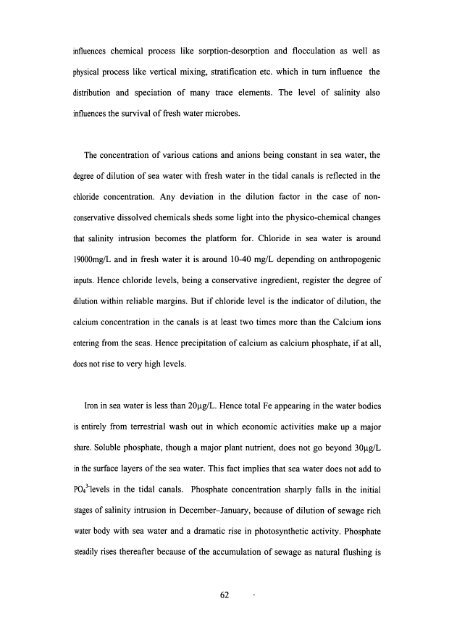Salinity Intrusion and Seasonal Water Quality Variations in the Tidal ...
Salinity Intrusion and Seasonal Water Quality Variations in the Tidal ...
Salinity Intrusion and Seasonal Water Quality Variations in the Tidal ...
Create successful ePaper yourself
Turn your PDF publications into a flip-book with our unique Google optimized e-Paper software.
<strong>in</strong>fluences chemical process like sorption-desorption <strong>and</strong> flocculation as well as<br />
physical process like vertical mix<strong>in</strong>g, stratification etc. which <strong>in</strong> turn <strong>in</strong>fluence <strong>the</strong><br />
distribution <strong>and</strong> speciation of many trace elements. The level of sal<strong>in</strong>ity also<br />
<strong>in</strong>fluences <strong>the</strong> survival of fresh water microbes.<br />
The concentration of various cations <strong>and</strong> anions be<strong>in</strong>g constant <strong>in</strong> sea water, <strong>the</strong><br />
degree of dilution of sea water with fresh water <strong>in</strong> <strong>the</strong> tidal canals is reflected <strong>in</strong> <strong>the</strong><br />
chloride concentration. Any deviation <strong>in</strong> <strong>the</strong> dilution factor <strong>in</strong> <strong>the</strong> case of non<br />
conservative dissolved chemicals sheds some light <strong>in</strong>to <strong>the</strong> physico-chemical changes<br />
that sal<strong>in</strong>ity <strong>in</strong>trusion becomes <strong>the</strong> platform for. Chloride <strong>in</strong> sea water is around<br />
19000mg/L <strong>and</strong> <strong>in</strong> fresh water it is around 10-40 mg/L depend<strong>in</strong>g on anthropogenic<br />
<strong>in</strong>puts. Hence chloride levels, be<strong>in</strong>g a conservative <strong>in</strong>gredient, register <strong>the</strong> degree of<br />
dilution with<strong>in</strong> reliable marg<strong>in</strong>s. But if chloride level is <strong>the</strong> <strong>in</strong>dicator of dilution, <strong>the</strong><br />
calcium concentration <strong>in</strong> <strong>the</strong> canals is at least two times more than <strong>the</strong> Calcium ions<br />
enter<strong>in</strong>g from <strong>the</strong> seas. Hence precipitation of calcium as calcium phosphate, if at all,<br />
does not rise to very high levels.<br />
Iron <strong>in</strong> sea water is less than 20Jlg/L. Hence total Fe appear<strong>in</strong>g <strong>in</strong> <strong>the</strong> water bodies<br />
is entirely from terrestrial wash out <strong>in</strong> which economic activities make up a major<br />
share. Soluble phosphate, though a major plant nutrient, does not go beyond 30Jlg/L<br />
<strong>in</strong> <strong>the</strong> surface layers of <strong>the</strong> sea water. This fact implies that sea water does not add to<br />
P04 3 -levels <strong>in</strong> <strong>the</strong> tidal canals. Phosphate concentration sharply falls <strong>in</strong> <strong>the</strong> <strong>in</strong>itial<br />
stages of sal<strong>in</strong>ity <strong>in</strong>trusion <strong>in</strong> December-January, because of dilution of sewage rich<br />
water body with sea water <strong>and</strong> a dramatic rise <strong>in</strong> photosyn<strong>the</strong>tic activity. Phosphate<br />
steadily rises <strong>the</strong>reafter because of <strong>the</strong> accumulation of sewage as natural flush<strong>in</strong>g is<br />
62

















